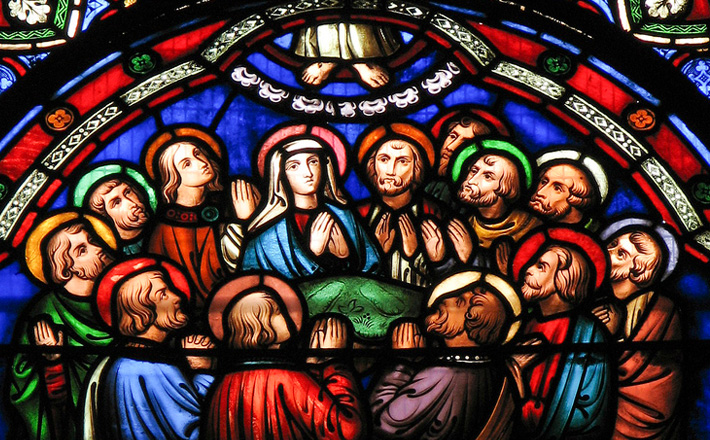Commentary on Acts 1:6-14
Falling forty days after Easter, Ascension Day has never held that important a place in the church calendar.1
Its place in Christian tradition, however, has been securely fixed by its prominent role in Christian creeds and confessions. A myriad of creeds and confessions echo the claim of the Niceno-Constantinopolitan Creed that Christ “ascended into heaven.”2 Although there are NT references and allusions to Christ’s ascension (e.g., Luke 24:50-53; John 20:17; Ephesians 4:8-10; 1 Timothy 3:16), only Acts 1 provides a full narrative of the event.
Both Jewish (e.g., 2 Kings 2:9–11) and Greco-Roman (e.g., Plutarch, Rom. 28:13) assumption stories accentuate the elevated status of their subjects.3 Likewise, the ascension of Jesus functions to underline the exaltation of Jesus. It is the fitting conclusion to the ministry of Jesus (so Luke 24:50–53); more importantly, here, it is the foundation of the church which makes the life of the church both possible and intelligible. The departure of Jesus inaugurates the beginning of the church — the gift of the Holy Spirit at Pentecost and the beginning of the worldwide mission.
In addition to the significance of the ascension for Luke’s story and theology, these opening verses focus as much on the response of the disciples to Jesus as they do on his words and deeds. This second section contains two parts and each one concludes with a reproof of and a promise to the disciples. In Acts 1:7–8, Jesus responds with a reproof: “It is not for you to know the times or seasons that the Father has established by his own authority”(cf. Matthew 24:36); and a promise (1:8a): “But you will receive power when the Holy Spirit comes upon you and you will be my witnesses.” This empowerment will enable the disciples to engage in a world-wide mission, “beginning in Jerusalem, throughout Judea and Samaria, and to the end of the earth” (1:8b; cf. Matthew 28:19-20).
Likewise, at the conclusion of Acts 1:9–11, we read the angelic response in two parts: a reproof (1:11a): “Galileans, why are you standing (there) looking at the sky?” and a promise (1:11b): “This Jesus, who was taken up from you into the sky, will come (back) in the very same manner that you saw him go into the sky” (cf. Luke 21:27). Despite the reproaches, both dialogues end with promises to the disciples, thus inviting a favorable judgment of the disciples by the audience.
The dating of the Pentecost requires that the hiatus between Easter and Pentecost be filled — this Luke does by the forty days of instruction. Through being taught by the risen Lord, praying together with one accord, and performing the delicate and crucial task of selecting Judas’s replacement without incident, the formal features of the opening scene depict the disciples as informed, spiritually mature, and administratively equipped — all signs that they are prepared to undertake the task of worldwide mission which lies before them (cf. Matt 28:19-20).
When Jesus ascends, his ascent into heaven is described in “earth-bound” terms, not as a heavenly journey in which the narrator accompanies the hero (as is the case in many heavenly journeys in late antiquity). The phrase, “into the sky” (or “heaven”), occurs four times in rapid succession emphasizing that Jesus is taken from the eyes of the disciples and thus from the audience’s “visual” field.
In Acts 1:10, the two messengers ask: “Galileans, why are you standing (there) staring at the sky?” Again, just as the disciples’ words seemed reasonable in their question to Jesus, so also their actions seem most natural. What else should one do when Jesus ascends except stand and look into heaven after him! Idly gazing into heaven, however, is an inappropriate response to Jesus’ ascension. The messengers assure the disciples (and audience) that Jesus will return in just the same way he left.
Despite Christ’s departure, there is no need, however, to speak of an “absentee Christology” in Acts. Though absent as a character from the narrative of Acts after chapter 1 (though see Acts 7:56), the influence of Jesus throughout the rest of the narrative is profound. His name occurs no less than 69 times in Acts. He is at the center of the church’s controversy with the Jews. He guides the church in its missionary efforts; he empowers the disciples to perform miracles. The ascended and exalted Christ, though absent as a character, is nonetheless a constant presence throughout the narrative.
The scene ends with the disciples’ return to Jerusalem (1:12-14). The list of followers is extended in Acts to include women and the family of Jesus, inviting the audience perhaps to revise the definition of disciple and the understanding of who was present at the ascension. To mention “women” is unusual for a succession list. “Mary, the mother of Jesus” stands as a bridge figure between the women who followed Jesus (see Luke 8:2; 23:49, 55; 24:10) and the family of Jesus, which (except for James) receives no further mention in the text. Jesus’ followers return to the upper room where they “devoted themselves together to prayer” (1:14).
The ascension narrative has long puzzled modern interpreters.4 John A.T. Robinson began his theological bombshell, Honest to God (1963), by asserting the impossibility of taking the ascension account literally. Karl Barth (among a host of others) also commented on the difficulty in gleaning a “nucleus of genuine history” from Acts 1 (CD III.2.452). Even a traditional scholar like N.T. Wright has balked at taking the ascension story as a straightforward, historical account: “the language of ‘heaven and earth’, though it could be used to denote sky on the one hand and terra firma on the other, was regularly employed in a sophisticated theological manner, to denote the parallel and interlocking universes inhabited by the creator god on the one hand and humans on the other.”5
Like Wright, theologian Oliver O’Donovan has attempted to steer a media via between those who see the ascension as a literal event and those who assign it to a “mental” or purely “spiritual” realm.
The ascension is not only a ‘taking from’, it is a ‘taking up.’ It is a material event which involves the material body of Jesus; it leaves the spatio-temporal order to enter the immediate presence of the Creator … The transition from the earth to Heaven is more than a reversal of the incarnation, at which God ‘came down’; it is the elevation of man, physical, spatio-temporal man, into an order that is greater than the physical and the spatio-temporal, and which is not his native habitat … All we can say is that the transition has occurred, that there is a beaten path that lies before us, linking our physical existence to an existence in the presence of God which lies beyond its conditions. We cannot see the path — the cloud which hid Jesus on the mountain-top is a veil for that which cannot be comprehended from below — but we know that the path has been taken, and that we are to take it too.6
Material adapted from The Acts of the Apostles. Paideia Commentary Series. Eds. Mikeal C. Parsons and Charles H. Talbert. Grand Rapids: Baker Academic (a division of Baker Publishing Group), 2008. Used by permission.
Notes:
- Commentary first published on this site on June 1, 2014.
- Jaroslav Pelikan and Valerie Hotchkiss, Creeds and Confessions of Faith in the Christian Tradition (4 vols.; New Haven: Yale University Press, 2003), I.915.
- The following paragraphs are drawn from Mikeal C. Parsons, Acts (Paideia Commentaries on the New Testament; Grand Rapids: Baker Academic), 27-31, 35. Used with permission.
- The following paragraphs appeared in Heidi J. Hornik and Mikeal C. Parsons, The Acts of the Apostles Through the Centuries (Wiley Blackwell Bible Commentaries; Oxford: Wiley Blackwell, 2016).
- N. T. Wright, The Resurrection of the Son of God (Minneapolis: Fortress Press, 2003), 665.
- Oliver O’Donovan, Resurrection and Moral Order (Leicester: IVP, 1986), 36-37.


May 24, 2020